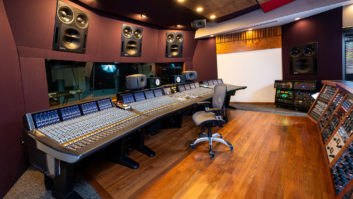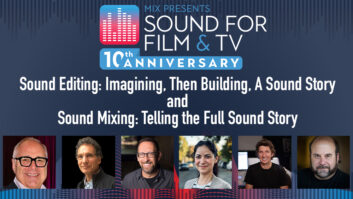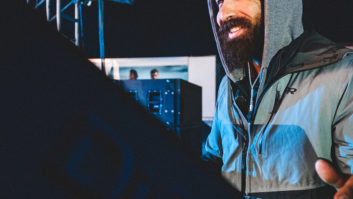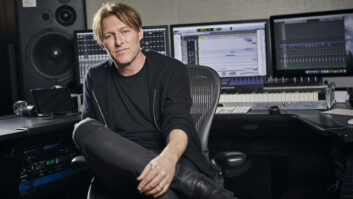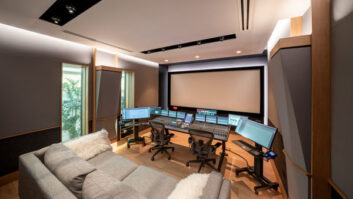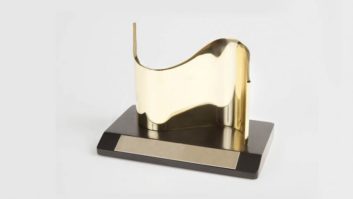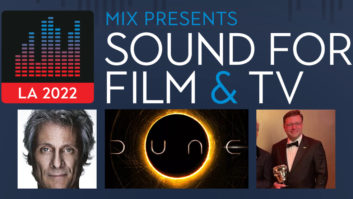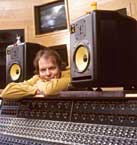
Ronald Prent with Galaxy’s API Vision and KRK monitors
Photo: Benny DeGrove
Galaxy Studios, owned by brothers Wilfried and Guy Van Baelen, has a history of doing things first — not just in their home base of Mol, Belgium, but in the world.
The expansive five-room facility installed the first AMS Neve MMC Aquarius digital console in mid-2003, which was preceded by the “world’s first” SPL MMC1 multichannel analog mastering console in December 2001 and followed by the API Vision in December 2003, an 80-channel board that’s “the first in the world dedicated to do all-discrete analog surround sound,” according to producer and Galaxy resident engineer Ronald Prent, who helped design the Vision with API’s Paul Wolf.
Prent presented his surround console requirements more than five years ago after feeling limited by the modified consoles he was working on at the time. He wanted a desk with “less buttons, but more functions,” he says. “The center section should be able to run surround in 5.1 but produce a true stereo mix at the same time. You should be able to switch independently between the two, and the console should take care of all the monitoring issues that would occur.”
Numerous discussions later, API delivered. Each channel on the Vision has two 100mm motorized faders for a total of 160 input channels, along with a surround bus and three stereo buses. “On this console, you can mix in stereo and surround or you can do up to three stems for film mixing at the same time,” Prent says. “And you can pan [a track] to wherever you want in a surround image. When you switch to stereo, it keeps the same balance, the same loudness.”
Prent recently remixed two Simple Minds albums for a DVD-A release on the Vision, working in part from original Bob Clear-mountain-mixed stereo masters. Prent also remixed 25 tracks for BMG’s forthcoming SACD Hybrid release of greatest hits from French cult group Indochine.
A serious Genelec surround system (1035B fronts, 1038 rears and dual 1094A subs); a closet stocked with more than 100 mics; a choice of Studer analog, Sony DASH and Pro Tools|HD 192 recording options; and access to a 484-square-foot recording space and the massive 82×49×26-foot (L×W×H) Galaxy Hall also make the API studio (aka the Blue Room) an attractive tracking space. German band Pur recently recorded a 45-piece string session in the Blue Room, while acts such as Lauryn Hill and Mary J. Blige and Telarc Records have occupied the other two main studios. (The third features a 72-channel Neve VR-P with Flying Faders and post-production panel.) Co-owner Wilfried Van Baelen recently maxed out the AMS Neve MMC when he used 250 channels in 24-bit/96 kHz, with 24 channels doing real-time sample rate conversion from 44.1 to 96k while mixing José Carreras’ latest album for SACD Hybrid release.
The facility’s ardent commitment to isolation is another advantage for clients. University of Leuven professor Gerrit Vermeir and Eric Desart of the Gerber Group designed each studio as an insulated bunker, put them on steel springs and installed 2.75-inch-thick, solid-glass windows in the control room and 4-inch-thick, 2,200-pound windows on the outside walls. “You can put a 60-piece orchestra in the main hall and somebody could be playing heavy metal in the control room next door, with visual connections, and you won’t hear a thing,” Prent says. “It’s amazing.”
While Galaxy is known as one of the leaders in DSD recording, this year, the studio has received more calls for DVD-A. “The funny thing is,” Prent explains, “in America, it’s more DVD-A — oriented, and in Europe, it’s far more SACD-oriented. But the Simple Minds album, for instance, is a DVD-Audio release for DTS and EMI London. So it’s starting to become more of a mixture, but we’ve had more SACD work during the last three years.”
Whatever the format request, Galaxy is equipped. The main studios contain complete 5.1 systems and can handle up to eight channels of DSD. The mastering room’s SPL MMC1 console, designed by the company’s Wolfgang Neumann and based on Prent and Bob Ludwig’s suggestions, can handle all foreseeable audio formats. “The console makes use of [SUPRA] op amps that operate at 120 volts,” Prent says. “This gives you a bandwidth of nearly 200 kHz, which is what they use in DSD recording and high-res PCM recording. This gives you a headroom of nearly 40 dB, which is incredible. There’s no limitation to what the console can do.”
The mastering room is measured to DSD standards and includes 16-channel SADiE ARTEMiS, Pyramix Virtual Studio, Sony Sonoma and Pro Tools|HD 192 workstations, which allow for SACD, CD, DVD, Dolby Digital and DTS mastering. The room also features an Eggleston Works loudspeaker system and equipment from DCS, Z-Systems, Millennia, Weiss, Philips, Tascam and 360 Systems, among others.
Galaxy celebrates the completion of its latest renovation (the kitchen) this year, concluding a 12-year building process and realizing the Van Baelen brothers’ “vision,” so to speak, that emerged after turning an old chicken shack into their first successful studio in 1980. “It’s an incredibly high investment, but it looks like it’s working for us at the moment,” says Prent of their latest installations. “In the end, there’s still artists and people in the record business that want a good product. It’s time that we put the value back in music.”
For more information, visit www.galaxy.be.
